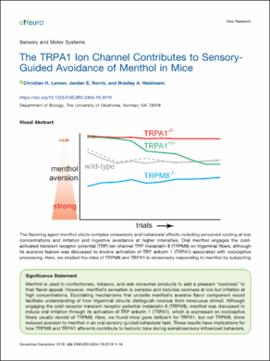| dc.contributor.author | Lemon, Christian H. | |
| dc.contributor.author | Norris, Jordan E. | |
| dc.contributor.author | Heldmann, Bradley A. | |
| dc.date.accessioned | 2019-11-08T18:29:57Z | |
| dc.date.available | 2019-11-08T18:29:57Z | |
| dc.date.issued | 2019-10-17 | |
| dc.identifier.citation | Christian H. Lemon, Jordan E. Norris and Bradley A. Heldmann eNeuro 17 October 2019, 6 (6) ENEURO.0304-19.2019; DOI: https://doi.org/10.1523/ENEURO.0304-19.2019 | en_US |
| dc.identifier.uri | https://hdl.handle.net/11244/321807 | |
| dc.description.abstract | The flavoring agent menthol elicits complex orosensory and behavioral effects including perceived cooling at low concentrations and irritation and ingestive avoidance at higher intensities. Oral menthol engages the cold-activated transient receptor potential (TRP) ion channel TRP melastatin 8 (TRPM8) on trigeminal fibers, although its aversive feature was discussed to involve activation of TRP ankyrin 1 (TRPA1) associated with nociceptive processing. Here, we studied the roles of TRPM8 and TRPA1 in orosensory responding to menthol by subjecting mice gene deficient for either channel to brief-access exposure tests, which measure immediate licking responses to fluid stimuli to capture sensory/tongue control of behavior. Stimuli included aqueous concentration series of (−)-menthol [0 (water), 0.3, 0.5, 0.7, 1.0, 1.5, and 2.3 mM] and the aversive bitter taste stimulus quinine-HCl (0, 0.01, 0.03, 0.1, 0.3, 1, and 3 mM). Concentration-response data were generated from daily brief-access tests conducted in lickometers, which recorded the number of licks water-restricted mice emitted to a randomly selected stimulus concentration over a block of several 10-s stimulus presentations. Wild-type mice showed aversive orosensory responses to menthol above 0.7 mM. Oral aversion to menthol was reduced in mice deficient for TRPA1 but not TRPM8. Oral aversion to quinine was similar between TRPA1 mutant and control mice but stronger than avoidance of menthol. This implied menthol avoidance under the present conditions represented a moderate form of oral aversion. These data reveal TRPA1 contributes to the oral sensory valence of menthol and have implications for how input from TRPA1 and TRPM8 shapes somatosensory-guided behaviors. | en_US |
| dc.description.sponsorship | This work was supported by the National Institutes of Health Grant DC-011579 and the Oklahoma Center for the Advancement of Science and Technology Grant HR16-108 (to C.H.L.).
Open access fees provided in whole or in part by the University of Oklahoma Libraries. | en_US |
| dc.language | en_US | en_US |
| dc.rights | Attribution 4.0 International | * |
| dc.rights.uri | https://creativecommons.org/licenses/by/4.0/ | * |
| dc.subject | ingestive behavior | en_US |
| dc.subject | menthol | en_US |
| dc.subject | trigeminal | en_US |
| dc.subject | TRP channels | en_US |
| dc.title | The TRPA1 Ion Channel Contributes to Sensory-Guided Avoidance of Menthol in Mice | en_US |
| dc.type | Article | en_US |
| dc.description.peerreview | Yes | en_US |
| dc.identifier.doi | 10.1523/ENEURO.0304-19.2019 | en_US |
| ou.group | College of Arts and Sciences::Department of Biology | en_US |

